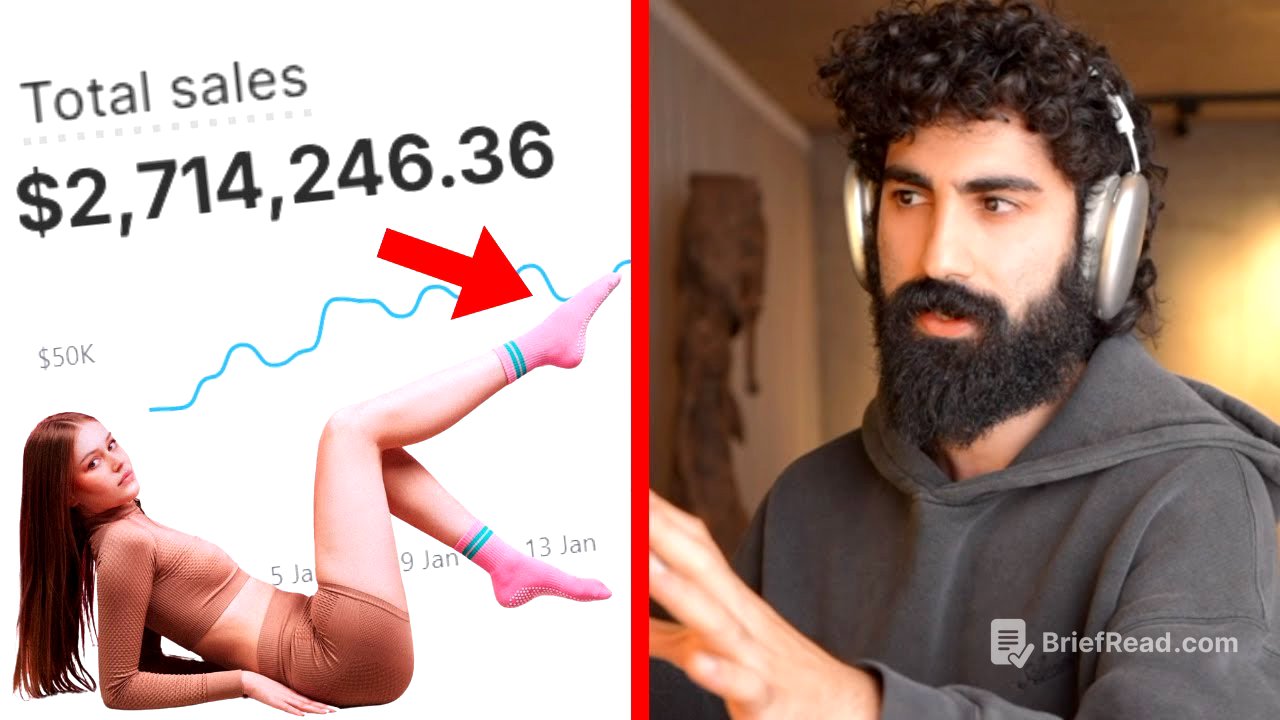TLDR;
This video explains how to build a $3 million brand in 30 days using an AI-driven strategy, even in a niche one is unfamiliar with. It covers identifying a growing market, finding untapped products through YouTube transcripts, understanding and emulating the target audience's identity for branding, sourcing high-quality suppliers, creating professional photoshoots, and crafting viral videos using the 1-3 second transition technique. The strategy involves targeting early adopters and leveraging the diffusion of innovation to capitalize on supply-demand discrepancies.
- Identifying a growing market and untapped products using AI.
- Branding by understanding and emulating the target audience's identity.
- Sourcing high-quality suppliers and creating professional photoshoots.
- Crafting viral videos using the 1-3 second transition technique.
- Targeting early adopters and leveraging the diffusion of innovation.
Finding a Growing Market and Untapped Products [1:02]
To start, it's important to enter a growing market rather than a stagnating one. The presenter chose the Pilates market due to its year-over-year growth on Google Trends and an 11.5% Compound Annual Growth Rate (CAGR), indicating strong future growth potential. The next step involves using YouTube to identify potential products. By searching for "day in the life of Pilates" (or similar keywords relevant to your niche), and analyzing the transcripts of long-form videos from micro-influencers, one can uncover products mentioned within these videos. Using a tool like ChatGPT, one can list all the products mentioned in the video that are early adopter products. This is how the presenter discovered Pilates grip socks, which showed exponential growth on Google Trends.
Understanding Your Target Audience [2:25]
The market research strategy not only helps in finding emerging products but also in understanding the target audience. By listening to how potential customers talk about the product, one can identify that they are aware of the product but not yet brand-aware. The presenter noted that the girls in the videos were calling the product "grippy socks" instead of specific brand names. This indicates product validation without brand saturation, which is an ideal market position.
Branding Based on Identity [3:06]
Creating a brand that resonates with the target audience involves understanding their identity. The presenter identified that the girls in the Pilates niche identified with the "that girl" aesthetic, which is a cross-cultural movement. To emulate this identity, the presenter researched brands that best fulfill this identity, such as Glossier, and emulated their brand essence. Glossier often used dreamy, cloudy sky backgrounds with blue pastels in their photoshoots, which became the inspiration for the presenter's photoshoot. The brand name "Grounded" was chosen to reflect the aspirational quality of the grip socks and align with the "that girl" aesthetic.
Sourcing High-Quality Suppliers [4:51]
To charge premium prices, the product quality needs to match the brand's resonance with the target audience. The presenter uses Alibaba to source high-quality suppliers. First, a manufacturing document is created with all the specifications, including variants, logo placement, silicon grip pattern, order quantity, materials, and lead time. Instead of searching by product, the presenter searches by supplier, filtering by trade assurance and verified pro supplier. By messaging 20 to 50 different suppliers, one can filter through them to find the perfect supplier and negotiate prices using the data collected.
Professional Photoshoot [6:03]
A professional photoshoot can solve many branding problems for the website, advertisements, and organic content. The presenter hired a director of photography specializing in fashion photography and sourced a backdrop similar to those used by "that girl" brands like Glossier. Models were chosen based on their resemblance to the "that girl" avatar on YouTube. The photoshoot included full-body lifestyle images for the website's hero image, product images for the featured product section, hero images for ads, and video clips for the website and organic content. The hero image featured a girl with the socks and a "stay grounded" overlay. The product images were placed in a minimalistic layout inspired by Brandy Melville.
Creating Viral Videos [8:00]
To capture the attention of the target audience, the presenter created a viral video that got 2.1 million views. The video begins with a stitch from a viral video within the Pilates niche to set up the context behind the product. The most important aspect of guaranteeing virality is the 1 to 3 second transition, which involves placing a re-engagement point at the 30-second mark of the video. This re-engagement point reveals the X factor of the content. Examples of this technique are shown in various viral videos, including e-commerce videos and personal brand videos.
Retargeting Advertising Campaign [11:04]
After generating millions of views from viral videos, the presenter ran a retargeting advertising campaign. The ads were shown to girls who viewed the viral videos, were interested in Pilates, knew about grip socks, and had seen the presenter's version of the grip socks. This resulted in a 7.19% conversion rate. The sales spike occurred when the retargeting advertising campaign was launched.
Understanding Early Adopters and the Diffusion of Innovation [12:02]
The girls who mentioned the product were early adopters, such as Pilates instructors and "pink Pilates princesses." Understanding the diffusion of innovation is crucial for spotting supply-demand discrepancies. The presenter explains that innovators are risk-tolerant and passionate, while early adopters are the influencers who validate a product before it becomes mainstream. Billionaire software developers understand this concept well and coined the term "product market fit," which involves meeting early adopters, gathering feedback, and gauging interest in the product. To build a successful business, one must find the early adopters and take inspiration from content validated by them. Opportunity in business lies in the supply and demand discrepancy revealed by early adopters.








![THE SPANISH ERA LITERATURE SHORT FILM 2024 [ROLEPLAY] [TAGALOG]](https://wm-img.halpindev.com/p-briefread_c-10_b-10/urlb/aHR0cDovL2ltZy55b3V0dWJlLmNvbS92aS9YdW5vSURRN0pJby9ocWRlZmF1bHQuanBn.jpg)
